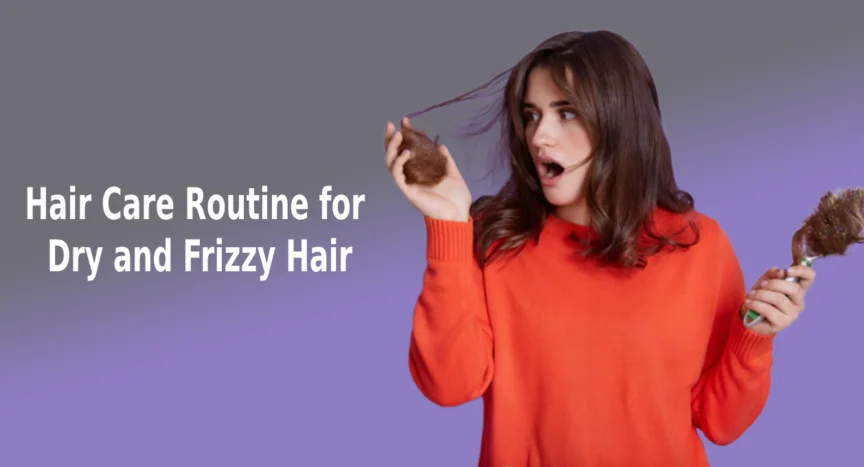Introduction
Dry, frizzy hair is a standard hair issue for many women and men across America. Whether it be from the harsh northern winter winds, south humid summers, or daily use of your favorite heat tools, you are not alone in this struggle. If you’re tired of struggling with dull, unruly strands, this comprehensive USA style guide will walk you through an effective hair care routine for dry and frizzy hair. You can expect to learn about the best shampoos and also about the significance of nutrition, all to get your smooth, healthy, and moisturized hair back.
Dry and Frizzy Hair: Understanding the Causes and Issues
Cleaning up the situation is first understanding why dry/frizzy hair occurs. Dry hair occurs when your hair doesn’t have enough moisture and/or the natural oils it needs, making it feel rough and brittle, as well as prone to breaking. Frizzy hair occurs when the hair cuticle, which is the outer layer of your hair, is either damaged or lifted enough to allow moisture to enter your hair unevenly. This causes the strands of your hair to swell and eventually lead to that puffy, unmanaged hair we all try to avoid.
In the USA, you have a wide variety of environmental factors to deal with. Cold winter months with dry indoor heat, humid months throughout the summer, exposure to the UV sun, air pollution, and, of course, chlorine from swimming pools can all lead to dry, frizzy hair. To top that off, the overuse of heat styling tools, such as flat irons, curling wands, and blow dryers, strip your hair of its natural protective oils, jeopardizing its health.
By identifying these common causes of dry and frizzy hair, you’ll be on your way to selecting the right hair care products and establishing daily practices according to your hair’s individual needs—putting you on your way to having smooth, healthy hair that you can manage.
Hair Care Routine for Dry and Frizzy Hair
Step 1: Choosing the Right Shampoo for Dry and Frizzy Hair.
The first step to any hair care routine is shampoo… but not all shampoos are the same. When it comes to dry and frizzy hair, I strongly recommend using a sulfate-free shampoo. Sulfates remove the natural oils from hair, thus drying it out more than it already is. Instead, look for shampoos with hydrating ingredients in them–ingredients like argan oil, shea butter, coconut oil, and aloe vera.
These ingredients gently cleanse your scalp while helping to replenish moisture levels while nourishing the hair strands. Many brands in the USA for dry and frizzy hair include Moroccanoil Hydrating Shampoo, SheaMoisture Raw Shea Butter Shampoo, and OGX Renewing + Argan Oil of Morocco Shampoo. These moisturizing shampoos will help to maintain your natural oil levels, decreasing your dryness and eventually helping with overall frizz control over time.
Step 2: Deep Conditioning and Regularly Conditioning
Conditioning hair is essential for sealing in moisture and smoothing the hair cuticle. After washing your hair, you should always use a generous, hydrating conditioner, and you should focus exceptionally well on the mid-lengths and ends of your hair, where dryness is more prominent. Ingredients like shea butter, avocado oil, and keratin are great for softening and strengthening hair.
For an added moisture lift, it is best to use a deep conditioning mask 1-2 times a week. Deep conditioners penetrate deeper into the hair shaft, helping to repair damage and replenish lost nutrients. I would highly recommend trying the Briogeo Don’t Despair, Repair! Deep Conditioning Mask and the Olaplex No. 8 Bond Intense Moisture Mask are both popular in hair salons and available for purchase across the USA. The regular use of conditioning products can improve the texture of hair and reduce breakage while controlling frizzy hair by smoothing the outer layer of each strand of hair.
Step 3: Use Leave-In Conditioners and Hair Oils for Daily Hydration
To help keep moisture present throughout your day, apply a leave-in conditioner or light hair oil on damp hair. Leave-in conditioners can consistently hydrate and protect your hair long after you have washed your hair, allowing for less frizz and dryness.
The most desired oils for dry and frizzy hair are natural emollients like argan oil, jojoba oil, and marula oil. These oils penetrate the hair shaft and nourish it without leaving hair greasy. They all contain antioxidants and vitamins that help revive shine and softness. When using oil, applying a touch on the ends of your hair is all you need, or a few drops all over for added smoothness – especially in the extreme weather of the USA.
Step 4: Protecting Hair from Heat Styling and Environmental Damage
Heat styling tools can cause severe damage to already dry and frizzy hair by stripping moisture and weakening hair strands. To protect your hair, always use a heat protectant spray before blow-drying, straightening, or curling.
Products like CHI 44 Iron Guard Thermal Protection Spray and TRESemmé Thermal Creations Heat Tamer Spray are widely trusted in the USA and provide a shield against high temperatures. Additionally, reduce heat styling frequency and try air-drying your hair when possible.
Environmental factors like UV rays and pollution also harm hair. Wearing hats, using UV protection sprays, and rinsing hair after exposure to chlorine or saltwater can help protect your hair from damage and reduce frizz.
Step 5: Protective Hairstyles and Nighttime Hair Care
Styles like loose braids, buns, and twists are referred to as protective hairstyles, and they minimize the exposure your hair has to environmental stress and friction. Ultimately, protective hairstyles are great because they help to prevent your hair from breaking and frizzing. Plus, protective hairstyles are just better at retaining moisture than loose styles are.
At night, it is a good idea to switch out your cotton pillowcases for silk or satin pillowcases to limit the friction that leads to hair breaking and frizzing. Silk and satin pillowcases will help your hair to retain moisture and keep the cuticle smooth. You can do other things to protect your hair while you are sleeping, like loosely braiding your hair or tying it in a loose bun; these can all help to reduce tangling while you are sleeping. Making an effort to be consistent with these small habits at night can benefit the hydration and smoothness of your hair.
Step 6: Nutrition and Hydration for Healthy Hair
Healthy hair shows that you are healthy overall as well, so nutrition and hydration are vital to fighting dry and frizzy hair. Vitamins A, C, D, and E, Zinc, and omega-3 fatty acids support hair strength, growth, and moisture retention. A healthy diet of eggs, nuts, fish like salmon, a variety of leafy greens, and fruits (especially citrus) will give your hair access to the vitamins it needs. It goes for the same with water intake; the more water you drink, the better hydrated your scalp and hair will always be.
Likewise, water availability is key to your skin. There may be times when supplements become necessary to maintain your hair health, but if you are taking vitamins for the first time, talk to a healthcare professional first. Probably the most beneficial approach is to establish a proper hair care regimen and balance it with a healthy diet to get your hair nourished and your hair to restore its natural luster and smoothness.
Step 7: Washing Frequency and General Hair Care Tips
Too much washing of dry and frizzy hair can take away your natural oils and cause more problems. A good goal is to wash your hair 2 to 3 times a week to promote moisture balance. When you do not wash your hair, you can use dry shampoo or simply brush to refresh your hair.
Do not use a rough towel to dry your hair; use your hands to gently squeeze out water, and use a microfiber towel or a soft cotton T-shirt to help eliminate frizz while reducing friction. Get your hair trimmed every 6 to 8 weeks. Regular trims will cut off split ends that can be a source of frizz and damage to hair. Gentle with your hair daily, and using the tips above will help with your hair texture, which helps manage frizz.
Frequently Asked Questions (FAQs)
Q1: How often should I wash dry and frizzy hair?
A1: Washing 2 to 3 times a week is ideal. Overwashing strips natural oils, worsening dryness and frizz.
Q2: What ingredients are best in shampoos for dry and frizzy hair?
A2: Look for sulfate-free shampoos with hydrating ingredients like argan oil, shea butter, and aloe vera.
Q3: Does heat styling worsen frizzy hair?
A3: Yes, heat styling can cause moisture loss and damage. Always use heat protectant sprays.
Q4: Are natural oils effective for frizz control?
A4: Absolutely! Oils like argan, jojoba, and marula deeply nourish and reduce frizz.
Q5: What protective hairstyles help with frizzy hair?
A5: Braids, buns, and twists minimize hair exposure to friction and environmental damage.
Conclusion
Managing dry and frizzy hair requires a consistent and nourishing hair care routine tailored to your unique needs and the USA’s diverse climates. From selecting the best shampoo and conditioner to protecting your hair from heat and environmental stress, every step counts toward healthier, smoother hair. Remember to nourish your body with a balanced diet and hydrate well to support your hair from the inside out. With patience and care, you can say goodbye to frizz and hello to beautiful, manageable hair every day.


Customer Reviews
Thanks for submitting your comment!